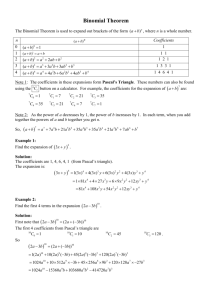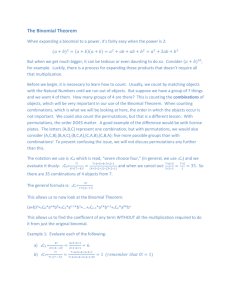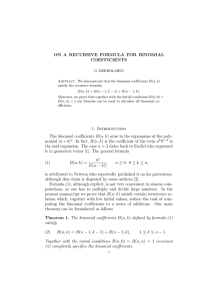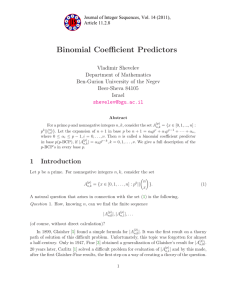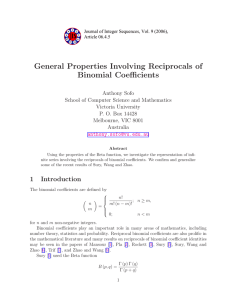The Binomial Theorem
advertisement
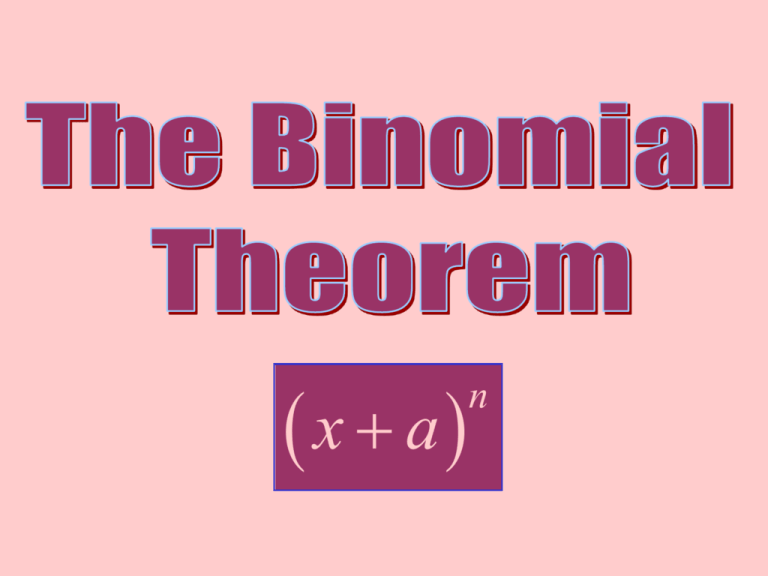
x a n A binomial is a polynomial with two terms such as x + a. Often we need to raise a binomial to a power. In this section we'll explore a way to do just that without lengthy multiplication. 0 x a 1 Can you see a 1 pattern? x a x a 2 2 2 x a x 2ax a Can you make a guess what the next one would be? 3 2 2 3 x a x 3 ax 3 a x a 3 x a x 4ax 6a x 4a x a 5 5 4 2 3 3 2 4 5 x __ ax __ a x __ a x __ a x a x a 4 4 3 2 2 3 4 We can easily see the pattern on the x's and the a's. But what about the coefficients? Make a guess and then as we go we'll see how you did. Let's list all of the coefficients on the x's and the a's and look for a pattern. x a 1 5 1x5 5ax 4 10a 2 x3 10a 3 x 2 5a 4 x 1a 5 1+1 1+2+1 x a 1 1 x a 1x 1a 2 2 2 x a 1 x 2 ax 1 a 0 1+3 3 1 + + 1 + 4 + 6 + 4 +1 1 5 3 2 2 3 x a 1 x 3 ax 3 a x 1 a 3 x a 4 10 10 1x 4ax 6a x 4a x 1a 4 3 2 2 3 4 5 1 Can you guess the next row? This is good for lower powers but could get very large. We will introduce some notation to help us and generalise the coefficients with a formula based on what was observed here. 1 1 1 1 1 1 2 3 4 5 1 1 3 6 1 4 10 10 1 5 1 This is called Pascal's Triangle and would give us the coefficients for a binomial expansion of any power if we extended it far enough. ! The Factorial Symbol ! 0! = 1 1! = 1 n! = n(n-1) · . . . · 3 · 2 · 1 n must be an integer greater than or equal to 2 What this says is if you have a positive integer followed by the factorial symbol you multiply the integer by each integer less than it until you get down to 1. 6! = 6 · 5 · 4 · 3 · 2 · 1 = 720 ! Your calculator can compute factorials. The ! symbol is under the "math" menu and then "prob". ! If j and n are integers with 0 j n, n the symbol is defined as j n n! j j ! n j ! This symbol is read "n taken j at a time" Your calculator can compute these as well. It is also under the "math" and then "prob" menu and is usually denoted nCr with the C meaning combinations. In probability, there are n things to choose from and you are choosing j of them for various combinations. n n! j j ! n j ! Let's work a couple of these: 5 5! 5 4 3 2 1 20 10 2 2 2! 5 2 ! 2 1 3 2 1 2 12 12! 12 1110 9! 220 9 9!12 9 ! 9! 3 2 1 We are now ready to see how this applies to expanding binomials. The Binomial Theorem x a n n n n n 1 x ax 0 1 n n a n The x's start out to the nth power and decrease by 1 in power each term. The a's start out to the 0 power and increase by 1 in power each term. The binomial coefficients are found by computing the combination symbol. Also the sum of the powers on a and x is n. 12 4 8 4 Find the 5th term of (x + a)12 5th term will have a4 (power on a is 1 less than term number) 1 less than term number 8 a x 495a x 4 So we'll have x8 (sum of two powers is 12) Here is the expansion of (x + a)12 …and the 5th term matches the term we obtained! In this expansion, observe the following: •Powers on a and x add up to power on binomial •a's increase in power as x's decrease in power from term to term. •Powers on a are one less than the term number •Symmetry of coefficients (i.e. 2nd term and 2nd to last term have same coefficients, 3rd & 3rd to last etc.) so once you've reached the middle, you can copy by symmetry rather than compute coefficients. Instead of x Instead of a we have 2x we have -3y Let's use what we've learned to expand (2x - 3y)6 First let's write out the expansion of the general (x + a)6 and then we'll substitute. x a 6 6 ax 5 15 20 a 3 x 3 15 6 a5 x a6 x 6 __ __ a 2 x 4 __ __ a 4 x 2 __ 3 y will 2 xbe 2 x 3 y 2 x 6 these the15same 3 y 2 x 3 3 4 2 5 6 will 20 3 y 2 x 15 3these y 2 x bethe 6 same 3 y 2 x 3 y 6 6 5 2 4 Let's confirm that Let's find the This will 6 6! 6 5! Let's find the also3be the Now we'll find 6 6 the 6 5 6!6! 6 655 44 2 this is also 3the 6 coefficient for 4! 3! coefficient forofthe 64 x 576 x y 2160 x y 4320 x y 1 1!5! 5! 15 20 coefficient of the of the coefficient second term. coefficient third 3 2 3!3! 2!4! 5 3 224! 3! 62nd tothe last3rd term. the 4thterm. term 2 4 to 4860 x y 62916 729 y 6! xy 6 5! last term. 6 formula Now we'll apply this to our 5! specific binomial. 5 5!1! Acknowledgement I wish to thank Shawna Haider from Salt Lake Community College, Utah USA for her hard work in creating this PowerPoint. www.slcc.edu Shawna has kindly given permission for this resource to be downloaded from www.mathxtc.com and for it to be modified to suit the Western Australian Mathematics Curriculum. Stephen Corcoran Head of Mathematics St Stephen’s School – Carramar www.ststephens.wa.edu.au



